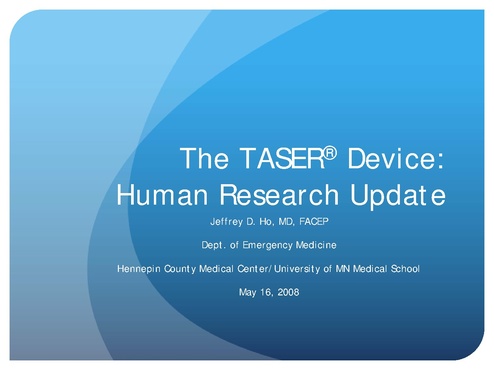Dr Jeffrey Ho Umn Med School Report Subj Taser Device Human Research Update May 16 2008
Download original document:

Document text

Document text
This text is machine-read, and may contain errors. Check the original document to verify accuracy.
The TASER® Device: Human Research Update Jeffrey D. Ho, MD, FACEP Dept. of Emergency Medicine Hennepin County Medical Center/University of MN Medical School May 16, 2008 Professional Qualifications y Emergency Medicine Physician y Minnesota Peace Officer y Academic Medical Researcher Disclosure y Consultant to TASER International (Non-Employee) y Personal Shareholder (No Options) y Partial Funding of some research projects from TASER International y Conflict Management Plan through the Minneapolis Medical Research Foundation y Conflict Management by Scientific Peer Review Objectives Why do people die after arrest? Misunderstanding Electricity y Electricity = Danger y Wall Sockets y Overhead Power Lines y Electricity as a form of Capital Punishment Misunderstanding Electricity y If Electricity causes a cardiac arrest, it does so in a very predictable fashion. Ventricular Tachycardia (VT), Ventricular Fibrillation (VF) result. y Why then, are the cases of sudden custodial death documented as rhythms other than VF or VT upon paramedic arrival? (They are typically Pulseless Electrical Activity or Asystole) y Why then, does history have documentation of sudden custodial death cases before the invention of the TASER in rhythms other than VF or VT? Misapplication of Logic y The “Post Hoc Fallacy” y “After this, therefore because of this.” y Assumes events close in time have a cause/effect relationship y Scientific process is needed to either validate or refute y Example: Rooster crowing associated with the sun rising TASER Research y TASER devices are not toys y They are not therapeutic medical devices y They should be evaluated in the context of their use y Start with the question of “What happens if. . .?” y Not with the question of “Can I cause this. . .?” Animal Research y Animal models can point towards certain directions but interpret the results with caution y Animal models are not great human substitutes. y Animals are anatomically different y Most are smaller in mass than a human y Some animal research has had concerning conclusions y These conclusions are reached in artificial environments y Human study in these areas have shown opposite conclusions Existing Human Evidence y TASER International has estimated over 675,000 voluntary training exposures with no deaths y What similarities exist in my studies? y Health/Age/Gender y Stature y Probe Position Human Research y Ho J, et al: Cardiovascular and physiologic effects of conducted electrical weapon discharge in resting adults. AcadEmerg Med, 2006. y No significant findings y Ho J, et al: Respiratory effect of prolonged electrical weapon application on human volunteers. AcadEmerg Med, 2007. y 15 second exposure y People breathe faster during exposure Minute ventilation Before = 13.2, pH Before = 7.4 Minute ventilation During = 18.7 pH After = 7.4 Human Research y Ho J, et al: Prolonged TASER use on exhausted humans does not worsen markers of acidosis. Am J Emerg Med, 2007-2008 In Press. y 15 seconds on acidotic, exhausted adults y No worsening of acidosis that is already present y Ho J, et al: Impact of conducted electrical weapons in a mentally ill population. Am J Emerg Med, 2007. y Review of TASER use during mental illness encounters. y TASER use 45% of time instead of justifiable deadly force Human Research y Ho J, et al: Absence of electrocardiographic change following prolonged application of a conducted electrical weapon in physically exhausted adults. AcadEmerg Med, 2007 supplement. y No EKG changes found after exposure y Moscati R, Ho J, et al: Physiologic effects of prolonged conducted electrical weapon discharge in ethanol intoxicated adults. AcadEmerg Med, 2007 supplement. y Alcohol consumption causes respiratory slowing y No changes when TASER is used on intoxicated humans Human Research y Dawes D, Ho J, et al: Effect of prolonged discharge from a conducted electrical weapon on human core temperature. J Forensic Sci, 2008 In Press. y No elevation in core temperature found Human Research (Drive Stun) y Ho J, et al: Prolonged TASER drive stun exposure in humans does not cause worrisome biomarker changes. PrehospEmerg Care, 2008 Supplement. y Drive stuns do not markedly change physiology y Ho J, et al: Confirmation of respiration during trapezial conducted electrical weapon application. AcadEmerg Med, 2008. y Dynamic demonstration that breathing occurs Human Research y Ho J, et al: Echocardiographic evaluation of a TASER X26 application in the ideal human cardiac axis. AcadEmerg Med, 2008 In Press. y Replicates 3 concerning swine studies y No evidence of cardiac rhythm problem in humans Human Research y Current Work: y XREP work on humans y C2 work on humans y X26 methamphetamine study y X26 human studies examining various physiology parameters under various stress factors Future Research Example VS. VS. Grappling and Pepper Spray exposure appear to be more stressful than TASER Validation Studies Chan et al. Respiratory and Ventilatory Effects of the TASER on Human Subjects. AcadEmerg Med , 2007;14 (Suppl 1):191-192. Sloane et al. Serum Troponin I Measurement of Subjects Exposed to the TASER X-26. AcadEmerg Med, 2007:14 (Suppl1):103-104. Vilke et al. Cardiovascular and Metabolic Effects of the TASER on Human Subjects. AcadEmerg Med, 2007:14 (Suppl1):104-105 Vilke et al. Does the TASER Cause Electrical Changes in Twelve Lead ECG Monitoring of Human Subjects. AcadEmerg Med, 2007:14 (Suppl1):104. Sloane et al. Cardiac Monitoring of Human Subjects Exposed to the TASER. J Emerg Med, 2007;33:113-117. Barnes Jr DG, et al. Cardiac effects of the TASER conducted energy weapon. Ann Emerg Med, 2007;48 (supplement):S102. Bozeman WP, et al. Injury profile of electrical conducted energy weapons. Ann Emerg Med, 2007;50 (supplement):S565. Conclusions y Beware of faulty logic y The current body of human research does not support a connection between the TASER device and sudden death through any mechanism that is known to modern medicine Questions?

